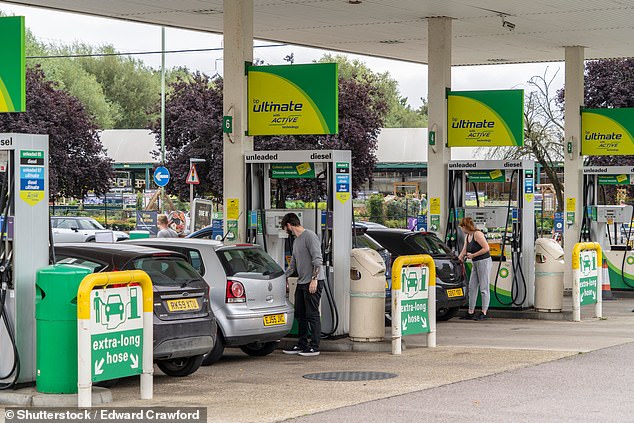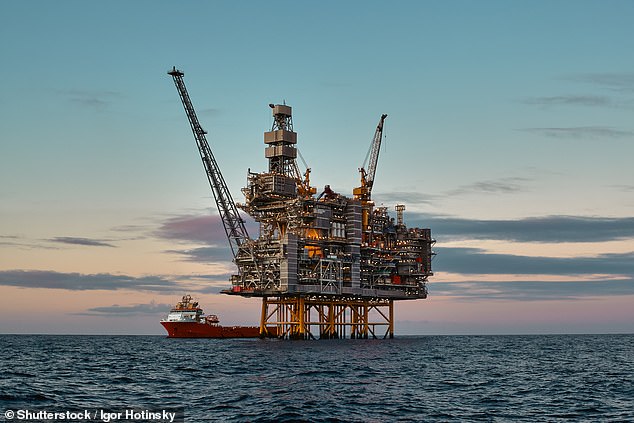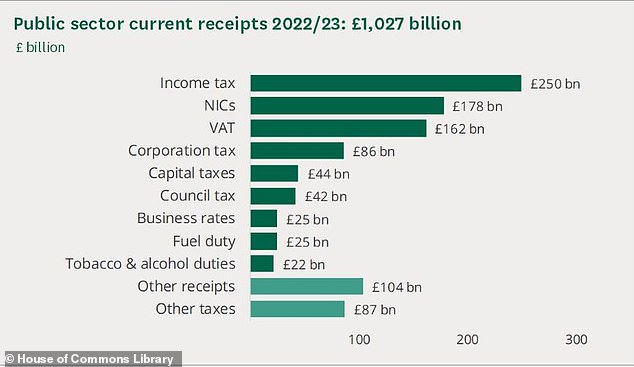Prices at the pump are dropping faster than ever before: How much are you saving on fuel?
The RAC has confirmed that prices of both unleaded petrol and diesel are falling faster in 2024 than at any other time so far.
Analysis by RAC Fuel Watch shows both fuels are now almost 7p cheaper than a month ago.
The RAC also predicts prices will fall to a three-year low as early as September, thanks to low crude oil prices and a strong pound.
Analysis by RAC Fuel Watch has found that petrol and diesel are now almost 7p cheaper than they were a month ago
On September 19, a litre of unleaded petrol cost an average of 136.15p. That’s almost 7p lower than a month ago (142.86ppl) and 5p lower than the start of the month (141.26p).
Diesel also fell 5p, from 145.99ppl to 140.87ppl – again almost 7p lower than the same period last month (147.74p).
The sharp drop means both petrol and diesel are at their cheapest in almost three years, with unleaded drivers saving almost £4 on a tank.
Prices have not fallen this fast in a single month since December 2023, when average pump prices for both fuels fell by more than 7p.
But even then, prices at gas stations were significantly higher than they are today.

Simon Williams of the RAC said: ‘It’s really encouraging to see prices at the pump falling so quickly. We know this is not only good for motorists’ pockets but also for keeping inflation in check.’
And there’s more good news for motorists: the RAC expects average pump prices to fall to their lowest level in three years as early as the end of September.
If prices continue to fall as the RAC hopes, the average cost of a litre of petrol could fall to 132p and diesel to 138p in the next two weeks. That would be the lowest price drivers have paid for both fuels since July and September 2021 respectively.
If motorists shop wisely, they can benefit from prices that are significantly below average. For example, supermarkets are currently charging 133.23p for unleaded petrol and 137.69p for diesel.
Motorists in Northern Ireland, where the RAC finds pump prices to be the lowest, can fill up with petrol for just 131.5 people and diesel for 134.2 people.
Simon Williams, RAC fuel spokesman, said: “It’s very encouraging to see prices at the pump coming down so quickly. We know this is not only good for motorists’ pockets but also for keeping inflation in check.
‘Based on wholesale pump prices, which is what retailers pay to buy fuel in the first place, we know there is room for further price reductions, and we sincerely hope that pump prices will reach their lowest level in three years within the next few weeks.’
Why are pump prices dropping?
The low price of crude oil

Currently, oil prices are relatively low at $73 per barrel, due to lower global demand.
Currently, oil prices are relatively low, at $73 per barrel, due to lower global demand.
In April, oil prices hit a record high of $91 for the year. This $18 drop, combined with a strong pound, is driving down costs at the pump.
Declines in wholesale fuel prices lead to lower pump costs.
The industry standard is to charge 1p per litre at the pump for every $2 increase in the price of oil per barrel.
This means that a $20 increase results in a £5.50 increase in the cost of filling a typical 55-litre fuel tank.
And retail margins are driving up the price of petrol by more than 6p a litre.
The Competition and Markets Authority reported in early August Update interim monitoring of road fuel that ‘gasoline price spreads averaged 12.62 ppl in the four months to June, which was 2.55 ppl lower than in the previous four months – but still more than double the 2015-19 average of 6.51 ppl’.
Those 6 people mean motorists will have to pay an extra £3.30.
Relatively strong pound
A strong pound, combined with falling oil prices (helped by a fall in UK inflation), means UK fuel retailers are getting better value for money when buying new stock on the wholesale fuel market, as fuel is traded in US dollars.
Will fuel duty be increased in the October budget?

‘Abolishing the fuel duty cut will cause a £3.30 per fill-up shock to the budgets of the 28% of drivers who spend a fixed amount at a petrol station,’ says AA chairman Edmund King
Fuel duty was cut in March 2022, with the AA warning that the impact should not be underestimated.
The motorists’ organisation is now calling on the new government to continue the fuel duty cut ahead of the budget in October.
“Abolishing the fuel duty cut risks sending millions of low-income motorists back to an era of ‘permanently high’ fuel prices,” said AA Chairman Edmund King.
‘Abolishing the fuel duty cut will deliver a £3.30 per tank (standard 55 litres) shock to the personal and family budgets of the 28 per cent of drivers who spend a fixed amount when they go to a petrol station.’
The AA has warned that if the excise duty cut had not been implemented in March 2022, UK motorists would have faced average petrol prices of more than 150p per litre from February 21 to August 8.
Before Covid, the highest price UK motorists faced was £142.48 per litre in April 2012.

Fuel taxes are an important source of revenue for the government.
According to the Office for Budget Responsibility, excise duties on the purchase of petrol, diesel and various other fuels generate £24.4 billion for the Treasury every year.
This estimate includes the 5p per litre reduction and the import duty of 52.95p/litre.
This represents 2.3 per cent of all income and equates to £867 per household and 0.9 per cent of national income.
Some links in this article may be affiliate links. If you click on them, we may earn a small commission. That helps us fund This Is Money and keep it free. We do not write articles to promote products. We do not allow commercial relationships to influence our editorial independence.
